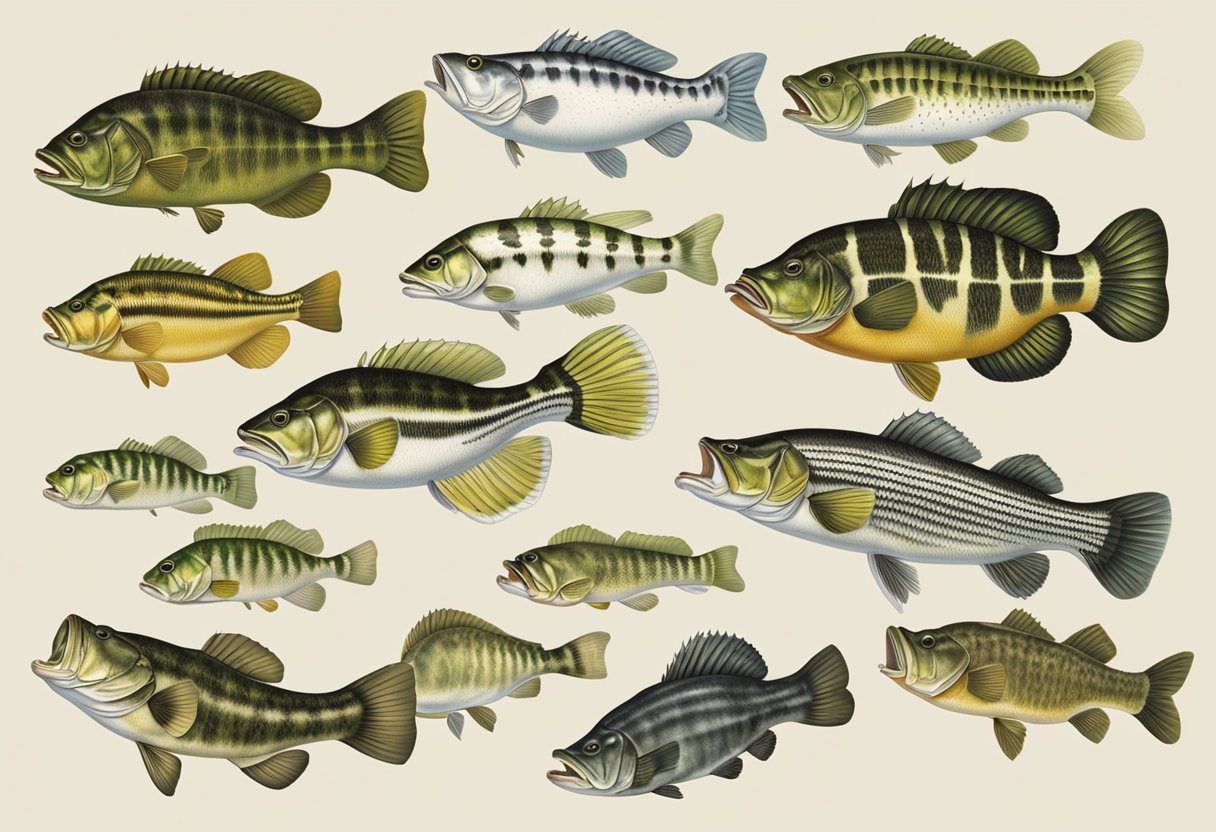Types Of Bass
Bass is a popular game fish that can be found in freshwater and saltwater environments all over the world. There are several different types of bass, each with its own unique characteristics and behaviors. Understanding the different types of bass and their habitats can help anglers choose the right gear and fishing techniques to increase their chances of success.
Black bass and temperate bass are the two main types of bass. Black bass, which include largemouth, smallmouth, and spotted bass, are the most commonly targeted by anglers. They are known for their aggressive behavior and hard fighting. Temperate bass, such as striped bass and white bass, are found in cooler waters and are popular among both recreational and commercial fishermen.
In addition to black and temperate bass, there are several other species of bass that are less well-known but still important to anglers and fisheries managers. These include the Suwannee bass, Guadalupe bass, and shoal bass, among others. Understanding the different types of bass and their habitats is essential for successful fishing and conservation efforts.
Key Takeaways
- Understanding the different types of bass and their habitats is essential for successful fishing.
- Anglers should choose the right gear and fishing techniques for the type of bass they are targeting.
- Conservation efforts for different types of bass are important to maintain healthy populations.
Understanding Bass Species

Bass species are a popular game fish found in freshwater and saltwater bodies across North America. These fish are known for their aggressive behavior and are a favorite target for anglers. There are several different types of bass species, each with unique characteristics and habitats.
Black Bass Varieties
The black bass is a member of the sunfish family and is one of the most popular game fish in North America. There are several different varieties of black bass, including the largemouth bass, smallmouth bass, spotted bass, Guadalupe bass, Alabama bass, Florida bass, and redeye bass. These fish are typically found in freshwater lakes, rivers, and streams.
The largemouth bass is the most well-known of the black bass varieties and is known for its large size and aggressive behavior. It can grow up to 2 feet in length and can weigh up to 20 pounds. The smallmouth bass is smaller in size and is known for its fighting ability. It can grow up to 2 feet in length and can weigh up to 10 pounds.
Temperate Bass Family
The temperate bass family includes fish such as striped bass, white bass, and yellow bass. These fish are known for their migratory behavior and are typically found in saltwater bodies, although they can also be found in freshwater rivers and lakes. Striped bass is the most popular of the temperate bass family and is known for its large size and aggressive behavior. It can grow up to 6 feet in length and can weigh up to 100 pounds.
Unique Bass Species of North America
North America is home to several unique bass species, including the shoal bass, Suwannee bass, and Alabama bass. The shoal bass is found in the Chattahoochee River and is known for its aggressive behavior and hard fighting ability. The Suwannee bass is found in the Suwannee River and is known for its striking appearance and aggressive behavior. The Alabama bass is found in Alabama and is known for its large size and hard fighting ability.
In conclusion, understanding the different bass species is crucial for any angler looking to catch these popular game fish. By knowing the characteristics and habitats of each species, anglers can better target and catch the fish they are after.
Habitat and Distribution
Bass are freshwater fish that can be found in various habitats, including rivers, streams, lakes, and ponds. They are also known to inhabit coastal and brackish waters. The distribution of bass varies depending on the species and their preferred habitat.
Freshwater Habitats
Largemouth bass and smallmouth bass are two of the most popular freshwater bass species in North America. They are found in rivers, streams, and lakes throughout the continent. Largemouth bass prefer warm, shallow waters with plenty of vegetation, while smallmouth bass prefer cooler, deeper waters with rocky bottoms.
Bass have a lateral line system that allows them to detect vibrations and changes in water pressure. This system helps them locate prey and navigate their environment. They also have two dorsal fins, which provide stability and maneuverability in the water.
Coastal and Brackish Waters
Some bass species, such as the European seabass and black seabass, can be found in coastal and brackish waters. The European seabass is found in the eastern Atlantic Ocean and the Mediterranean Sea, while the black seabass is found along the eastern coast of North America.
Bass in coastal and brackish waters have adapted to survive in saltier environments. They have specialized kidneys that allow them to excrete excess salt and maintain a healthy balance of fluids in their bodies.
In summary, bass are freshwater fish that can be found in a variety of habitats. Their distribution varies depending on the species and their preferred environment. Bass in freshwater habitats have a lateral line system and two dorsal fins, while those in coastal and brackish waters have specialized kidneys to help them survive in saltier environments.
Bass Fishing Techniques
Bass fishing is a popular sport that requires a combination of skill and patience. There are various techniques that anglers use to catch bass, including lure fishing and bait fishing.
Lure Fishing
Lure fishing involves using artificial lures to attract and catch bass. There are many types of lures that can be used, including spinnerbaits, jerkbaits, and Ned rigs. Spinnerbaits are one of the most reliable bass lures that an angler can have in their tackle box. They can be fished effectively year-round and are especially useful in murky water. Jerkbaits are another popular choice for bass fishing and can be used in both clear and murky water. Ned rigs are a newer type of lure that has gained popularity in recent years. They are small and compact and can be fished slowly to entice bass.
Bait Fishing
Bait fishing involves using live bait to catch bass. Some popular live baits include frogs, shad, and alewives. When using live bait, it is important to use the right equipment and techniques to ensure a successful catch. The right fishing rod, reel, and line are essential for bait fishing. It is also important to use the right bait for the type of bass you are targeting.
Overall, there are many techniques that can be used for bass fishing. Whether an angler chooses to use artificial lures or live bait, patience and skill are key to a successful catch.
Conservation and Management
Conservation and management of bass fish species are critical to ensure their sustainability for future generations. Bass fish are highly prized by anglers and play a significant role in the ecosystem. Therefore, it is essential to manage their populations and protect their habitats.
To conserve bass fish, it is crucial to understand their biology and ecology. Bass fish have different habitat preferences and life history traits, which make them vulnerable to overfishing and habitat degradation. For example, largemouth bass prefer shallow, weedy areas, while smallmouth bass prefer rocky habitats with clear water. Knowing these preferences can help in designing effective management strategies.
Sustainable fishing practices are essential to conserve bass fish populations. Catch-and-release practices can help reduce mortality rates and ensure that fish populations remain healthy. Regulations such as size limits, bag limits, and closed seasons can also be implemented to reduce overfishing.
Conservation efforts should not only focus on bass fish populations but also on their habitats. Habitat degradation, such as water pollution and habitat loss, can negatively impact bass populations. Therefore, it is crucial to protect and restore their habitats to ensure their long-term survival.
In conclusion, conservation and management of bass fish species are critical to ensure their sustainability. Sustainable fishing practices and habitat protection are essential components of conservation efforts. By implementing effective management strategies, we can conserve bass fish populations and ensure that they remain a valuable part of the ecosystem.
Choosing the Right Gear
When it comes to bass fishing, choosing the right gear is crucial for a successful outing. Beginners often struggle with selecting the right gear for fishing, but with a little guidance, they can make the right choice.
One important aspect of gear selection is the type of reel and gear ratio. A medium speed reel with a medium gear ratio is suitable for most baits, such as spinnerbaits, jerkbaits, swimming jigs, and topwaters. Slow-rolling requires a slower gear ratio, while fast gear ratios are too fast for most baits. Therefore, a medium gear ratio is just right for most situations.
Another important aspect of gear selection is the type of hook. A wide gap hook is a solid choice for many soft plastic baits used in bass fishing. It allows for better penetration and a secure hook set. The size and shape of the hook will vary with the type of bait used.
Vertical blotches are a distinguishing feature of the largemouth bass found in Tennessee. Anglers fishing in Tennessee should consider using lures that mimic the bass’s natural prey, such as crawfish and shad. A variety of lures can be used, including jigs, spinnerbaits, and crankbaits.
South Carolina is home to a variety of bass species, including largemouth, smallmouth, and spotted bass. Anglers fishing in South Carolina should consider using lures that mimic the bass’s natural prey, such as shad and bluegill. A variety of lures can be used, including jigs, spinnerbaits, and crankbaits.
In conclusion, choosing the right gear is an essential part of bass fishing. Anglers should select gear that suits their needs and the type of bass they are targeting. With the right gear, anglers can increase their chances of catching more and bigger bass.






